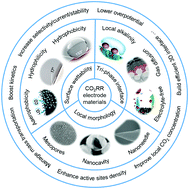Designing CO2 reduction electrode materials by morphology and interface engineering†
Abstract
Electrochemical reduction of CO2 into value-added fuels and chemicals driven by renewable energy presents a potentially sustainable route to mitigate CO2 emissions and alleviate the dependence on fossil fuels. While tailoring the electronic structure of active components to modulate their intrinsic reactivity could tune the CO2 reduction reaction (CO2RR), their use is limited by the linear scaling relation of intermediates. Due to the high susceptibility of the CO2RR to the local CO2 concentration/pH and mass transportation of CO2/intermediates/products near the gas–solid–liquid three-phase interface, engineering catalysts’ morphological and interfacial properties holds great promise to regulate the CO2RR, which are irrelevant with linear scaling relation and possess high resistance to harsh reaction conditions. Herein, we provide a comprehensive overview of recent advances in tuning CO2 reduction electrocatalysis via morphology and interface engineering. The fundamentals of the CO2RR and design principles for electrode materials are presented firstly. Then, approaches to build an efficient three-phase interface, tune the surface wettability, and design a favorable morphology are summarized; the relationship between the properties of engineered catalysts and their CO2RR performance is highlighted to reveal the activity-determining parameters and underlying catalytic mechanisms. Finally, challenges and opportunities are proposed to suggest the future design of advanced CO2RR electrode materials.



 Please wait while we load your content...
Please wait while we load your content...